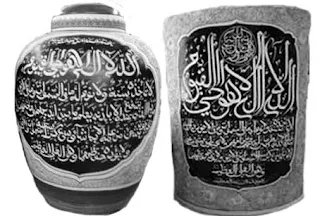Forms and characteristics of Islamic historical remains in various parts of Indonesia
1. Mosquest
History-Amosque is a place where Muslims performs their compulsory prayers. A mosque is also used as a place in which Muslims pray to God. Besides that, it sometimes also functions as a place where Muslims receive spiritual lessons through religious classes and discussions.
Historical remains in the form of mosques are spread in different areas, especially in former Islamic kingdoms. Below are some interesting things that characteristize the mosques as historical inheritances in Indonesia.
a. In terms of architecture, the roofs are mostly multi-layered where the upper layer is smaller than the lower one, the ground plans are rectangular or square, theya are provided with verandahs, and they have a pond equipped with a place for ablution in front or on the side.
b. There are no towers (minarets) from which the muezzin calls fro prayer (azan). In Indonesia, there are only two mosques which have minarets, Kudus and Banten mosques.
c. They are located near the palace, usually in the west of the town square, or near the grave of a king, 'wali' or ulama.
Some examples of mosques which were built during the period of Islam development are : Demak mosque, Menara Kudus mosque, and Sendang Duwur mosque (Tuban).
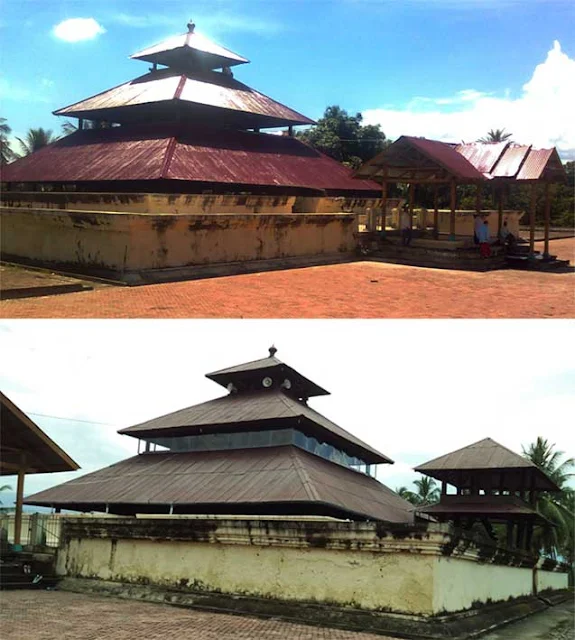 |
| Mosque in Aceh that is shaped like a multi level pyramid |
2. Palaces
A palace is a place where most important activities related to a kingdom's affairs are conducted, it is also the residence of the king and his family. It is built in the capital of the kingdom as a symbol of the center of government's authority. Most of the palaces which still stand today were built during the period of Islam development, and the majority face the north.
A palace normally has a main building which is usually encircled by a wall and a man-made stream or ditch. To enter this main building, one has to pass the palace's gate.
In front of the palace, there is a large field which is called 'alun-alun' (town square). A banyan tree is usually planted in the center of the square to sy,bolize the king's protection of the people. The town square is used as the place where the king meets his people on certain occasions, a place to do military exercise for the royal soldiers, and a place to hold entertainment programs or certain ceremonies.
This type of square is not only found in front of a king's palace but also in provincial towns or the towns of 'adipati' or regents.
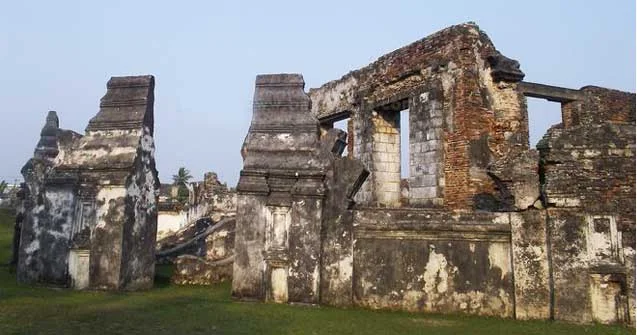 |
| Remains of gates at Kaibon Banten |
3. Tombstones (Graves)
A tombstone is a short post planted on the site of a grave. Some ancient tombstones of Islamic style were imported from Gujarat, India. This was found out by comparing the tombstones in some graveryards in Indonesia with some tombstones in Gujarat.
The examples of such tombstones are the tomstones at the grave of Maulana Malik Ibrahim in Gresik and the grave of Sultan Malik Al-Saleh, the king of Samudera Pasai.
Who is Maulana Malik Ibrahim? Please read : The role ulamas in the early development of Islam in Indonesia
Who is Maulana Malik Ibrahim? Please read : The role ulamas in the early development of Islam in Indonesia
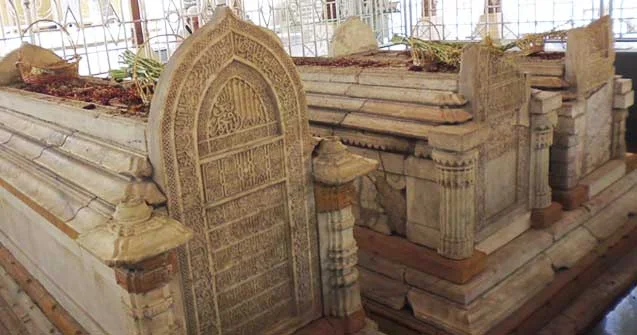 |
| Grave of Maulana Malik Ibrahim, one of the Walisanga. |
4. Calligraphy
Calligraphy is the art of artistic hardwriting. Besides painting, calligraphy also developed in the 16th and 17th centuries. The calligraphy developing at that time was artistic writing in Arabic on a stone or wood.
Calligraphy works are commonly used in mosques and graves. The part of a mosque which is decorated with calligraphy is usually the podium, like what is found in Mantingan mosque in Jepara.
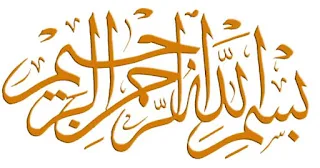 |
| Arabic calligraphy |
5. Literary works
The Islamic leterary works of Indonesian men of letters consist of tales, chronicles, poems, and 'suluk'.
a. Tales, these are literary works in the form of imaginary stories for entertainment of encouragement. The ususally contain miracles or illogical events.
Sometimes a tale begins with a story about a historical figure who really existed. Examples of such tales are : Hikayat Amir Hamzah and Hikayat Hang Tuah.
b. Chronicle, a sort of history that is more like a story than a historical account. Examples : Babad Tanah Jawi (Chronicle of Java) and Babad Giyanti (Chronicle of Giyanti).
c. Poems, these are traditional poems in which each stanza consists of four lines with the same rhyme. Examples : Gurindam Dua Belas and Syair Abdul Muluk.
d. Suluk, this is a type of book that compares mysticism subjects. Suluk is the oldest literary work inherited by some Islamic kingdoms in Nusantara. Most suluks were written by walis (notable ulamas) or at least related to a certain wali.
In Indonesia, there were many thinkers and ulamas who had contributed a lot to the spread, care and development of Islamic sharia and culture. Their role was just as important as the role of Walisanga. The even continued the struggle of Walisanga.
Some of the valuable contributions given by thinkers and ulamas to the development of Islam in Indonesia were in the form of Islamic works. The following are some of the thinkers and ulamas of the 16th and 17th centuries who had produced Islamic works.
- Hamzah Fansuri who wrote 'Syair Perahu (literally, boat verses) which stated that man was symbolized as a boat sailing in God's ocean. To face any danger; he had to have strong belief in the oneness of God and knoledge. His other work was 'Syair Burung Pinga' (verses of pingai bird) which depicted that human spirit was similar to a bird that was God's creation.
- Nuruddin ar-Raniri with his famous work titled Bustanus Salatin (Kings' Garden).
- Bukhari Al-Jauhari with his well-known work titled Tajus Salatin (Kings' Crown).
- Syamsuddin as-Samantrani whose well-known work was titled Mir'at al Muminin (the Muslims' Mirror) which consisted of questions and answers.
- Abdurrauf whose works included Kifatul Muhtajin, Daqich al-Huruf, Bayan Terjalli, and Umdat al-Muhtadin.
Thanks you for visited website history
